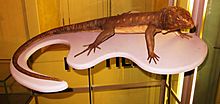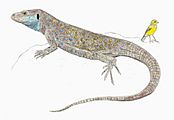Gallotia goliath facts for kids
The Tenerife giant lizard, also known as Gallotia goliath, was a huge lizard that once lived on the island of Tenerife. This island is part of the Canary Islands in Spain. This amazing reptile lived long ago, even before people arrived on the island. Scientists believe it could grow to be at least 0.9 meters (about 3 feet) long! A German scientist named Robert Mertens first described this giant lizard. We know about these lizards because their fossils have been found in volcanic caves. Often, their bones are found alongside those of other ancient animals, like the Tenerife giant rat.
Quick facts for kids Gallotia goliathTemporal range: Late Pleistocene-Holocene
|
|
|---|---|
 |
|
| Skull in Museo de la Naturaleza y el Hombre of Santa Cruz de Tenerife. | |
| Scientific classification | |
| Genus: |
Gallotia
|
| Species: |
goliath
|
| Synonyms | |
|
|
Contents
What Kind of Animal Was It?
Scientists have studied the bones of ancient Gallotia lizards. They once thought there were two types: G. maxima and G. goliath. However, they later found that G. maxima was actually the same as G. goliath. This means G. goliath was the correct name for this species.
For a while, people thought G. goliath lived on several Canary Islands. But new studies, including DNA tests from mummified remains, showed that G. goliath probably only lived on Tenerife. It seems to be closely related to the Tenerife speckled lizard (Gallotia intermedia).
How Big Was the Tenerife Giant Lizard?
The Gallotia goliath was the biggest reptile ever known in the Canary Islands. It could grow to be about 120 to 125 centimeters (around 4 feet) long. That's taller than many kids!
In 1952, scientists found a skull that was 13.5 centimeters (about 5 inches) long. This discovery suggests that some of these lizards might have grown even larger than the average size. These huge lizards preferred to live in the low-lying coastal areas of Tenerife.
Why Did the Tenerife Giant Lizard Disappear?
The Tenerife giant lizard lived on the island from the late Pleistocene period through the Holocene period. It survived until the 1400s.
Scientists have found bones of this lizard at old human sites. These bones sometimes have marks on them. This suggests that the native people of the island, called the Guanches, may have hunted and eaten these lizards.
There are also old writings from the 1400s that mention these lizards. This means they were still alive when people from Castile (now part of Spain) arrived and took over the Canary Islands. It is believed that the Tenerife giant lizard became extinct sometime after this time, likely due to human activities and the introduction of new animals.
Gallery
-
An artist's drawing of the Tenerife giant lizard, based on its bones and living Gallotia lizards. A small Atlantic canary is shown next to it to help you see how big it was.
See also
 In Spanish: Gallotia goliath para niños
In Spanish: Gallotia goliath para niños
- Island gigantism
- List of largest extinct lizards




